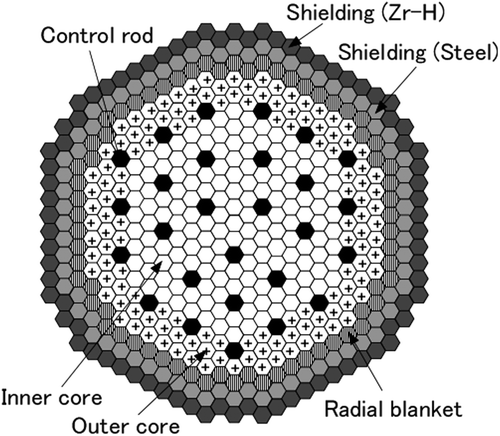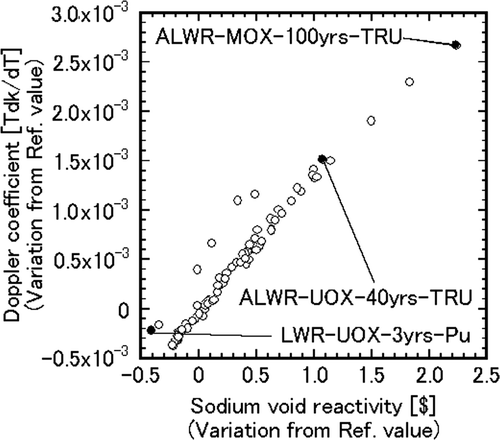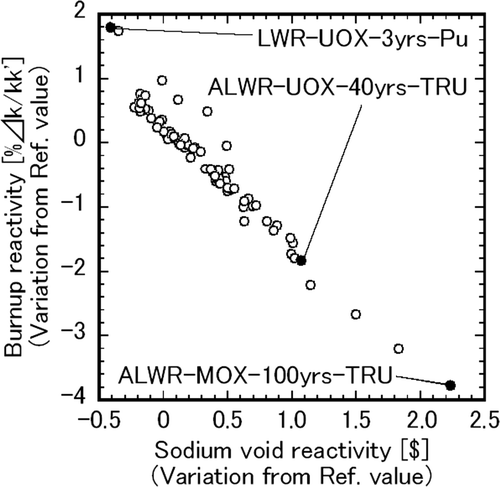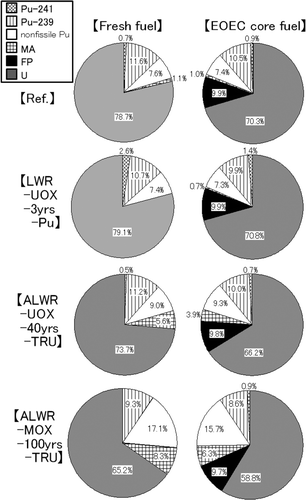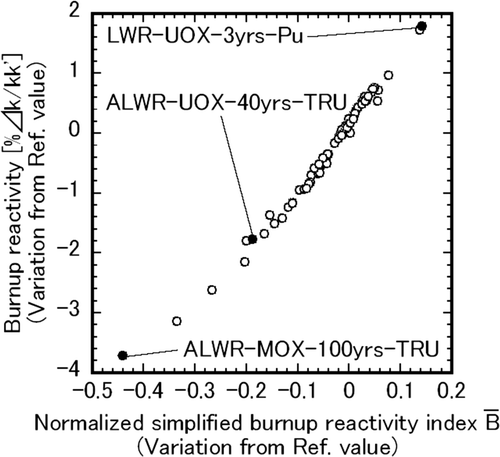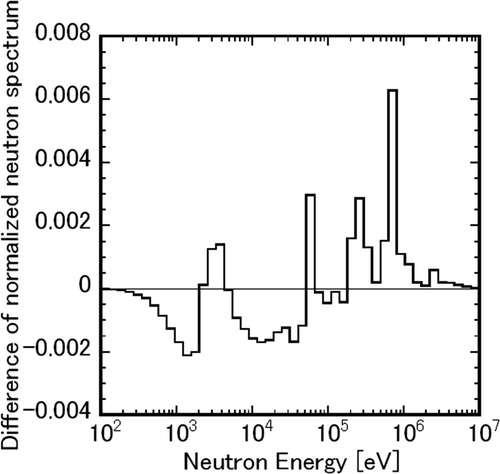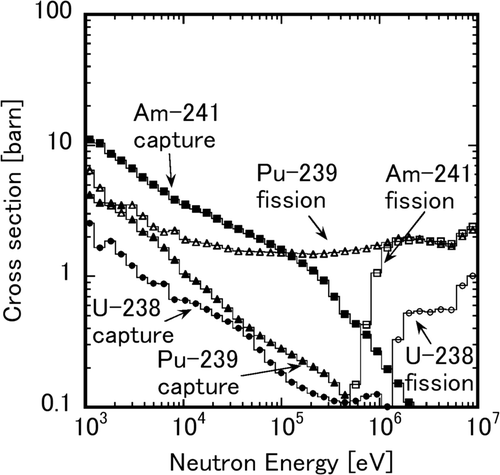Abstract
In the design of a fast breeder reactor (FBR) core for the light water reactor (LWR) to FBR transition stage, it is indispensable to grasp the effect of a wide range of fuel composition variations on the core characteristics. This study finds good correlations between burnup reactivity and safety parameters, such as the sodium void reactivity and Doppler coefficient, for various fuel compositions and determines the mechanisms behind these correlations with the aid of sensitivity analyses. It is clarified that the Doppler coefficient is actually correlated with the other core characteristics by considering the constraint imposed by the requirement of sustaining criticality on the fuel composition variations. These correlations make it easy to specify the various properties ranges for core reactivity control and core safety, which are important for core design in determining the core specifications and performance. They provide significant information for FBR core design for the transition stage. Moreover, as an application of the above-mentioned correlations, a simplified burnup reactivity index is developed for rapid and rational estimation of the core characteristic variations. With the use of this index and these correlations, the core characteristic variations can be estimated for various fuel compositions without repeating the core calculations.
1. Introduction
The fast breeder reactor (FBR) is a promising energy source that can support sustainable development of human civilization. While producing electric power, it can breed fissile material through the conversion of fertile material, which exists in abundance as a natural resource. Using uranium-238 and plutonium-239 (and -241) as fertile and fissile materials, respectively, it is expected that FBRs can provide a stable energy supply for a few thousand years. In order to deploy commercial FBRs to replace light water reactors (LWRs), a certain amount of fissile material is initially needed to be used like a pilot burner. This initial fissile material can be recovered from the spent fuel from LWRs.
Unlike the enriched uranium (U) fuel used for LWRs, the plutonium (Pu) used for FBRs has a wider variety of isotope compositions resulting from the various LWR spent fuel characteristics, which depend on reactor type, fuel type, discharge burnup, and cooling time. In the case of minor-actinide (MA) recycling in an FBR, the fuel composition of Pu and MAs, i.e. the nuclide composition of transuranic elements (TRU), becomes more complicated. In addition, the fuel compositions are changed by the recycling in the FBR system. Consequently, understanding and consideration of a wider range of core characteristics due to the various fuel compositions are required for FBR core design for the transition stage of the shift from LWRs to FBRs (L–F transition stage) [Citation1].
The fuel composition is one of the factors that significantly influence the core characteristics. In order to evaluate the effects of fuel composition change on core design, the FBR core characteristics were evaluated for various fuel compositions supposed for the L–F transition stage. The results of this evaluation are shown in Chapter 3, after an explanation of the reference FBR core in Chapter 2. In Chapter 4, the mechanism behind the core characteristic variations resulting from fuel composition changes is discussed with the aid of sensitivity analyses. The relation between the fuel composition and the core characteristics will be clarified here. Moreover, based on a consideration of this relation, a simplified index is developed in Chapter 5 for rapid and rational estimation of the core characteristic variation. Finally, we summarize this study in Chapter 6.
2. The reference FBR core
The reference FBR core employed in this study is based on a MOX fuel core for a Japanese sodium-cooled fast reactor, which is the most promising concept in the fast reactor cycle technology development (FaCT) project in Japan [Citation2–Citation4]. The core design specifications and core configuration are shown in and , respectively. A 750 MWe-class middle-size reactor is employed in this study. In Japan, a 1500 MWe-class large-size reactor is often referred to as a commercial reactor. However, both reactors have been adopted as references for the conceptual design study in the FaCT project, because the 750 MWe-class reactor is a candidate for use as a demonstration reactor. It would appear that there is no large difference between these reactors in terms of the fuel's TRU composition change during multiple FBR recycling operations, as long as the breeding ratio is the same.
Table 1. Core specifications.
The core employed in this study aims for a high average discharge burnup of about 150 GWd/t. The core consists of the following regions: inner and outer cores, axial and radial blankets, control rods, and steel and Zr-H shielding. The breeding ratio is intended to have some flexibility and is set from around 1.1–1.0. A breeding ratio of about 1.1 is needed for a smooth transition from an LWR to an FBR. On the other hand, if the radial blanket is replaced with steel shielding, it is possible to have a break-even breeding ratio of around 1.0, which is enough to eventually sustain an FBR fuel cycle. The reference fuel composition is an FBR multiple-recycling equilibrium TRU composition (see ). Minor-actinide recycling is assumed to be used here in order to reduce the environmental burden and efficiently utilize energy resources.
Table 2. Typical TRU compositions.
The core neutronic characteristics were evaluated using core calculations based on a 70-energy-group neutron diffusion theory for the two-dimensional R-Z geometry. Self-shielded cross sections were prepared for the homogeneous cell representations by using the adjusted cross-section library ADJ2000R [Citation5,Citation6]. This library incorporates integral experimental information about critical facilities and existing fast reactors. The design values were determined by best estimate evaluations, taking into account neutron transport, spatial mesh, and cell-heterogeneity corrections.
The sodium void reactivity was calculated by assuming the loss of all the sodium inside the fuel assemblies in the active core region. Note that the sodium between the wrapper tubes and the inner ducts inside them was kept. The Doppler coefficient was calculated by assuming the temperature increment of the fuel. The temperature was increased by 500 K for active core fuel and not changed for the blanket fuel and structural materials.
The TRU enrichment of fresh fuels in the inner and outer core was determined to flatten the radial power distribution and to keep the core critical during an equilibrium-cycle operation. A depleted U composition of U-235/U-238 = 0.3/99.7% is used for the core and blanket fuels.
The reference core characteristics evaluated using the reference TRU composition and the above-mentioned methods are summarized in . It can be seen that the reference core achieves the target breeding ratio of 1.10 and core average discharge burnup of 150 GWd/t.
Table 3. Major characteristics of the reference core.
3. Investigation of TRU fuel recycling characteristics in an FBR core
To evaluate the effects of fuel composition change during the L–F transition stage on core design, the change of TRU composition and core characteristics were evaluated, along with multiple recycling operations in the FBR core. TRU recovered from LWR spent fuels were used along with depleted U as the fresh TRU fuel for the initial FBR core. After burnup in the FBR core, the TRU were recovered again from the spent core fuel, together with the blanket fuel. Five years of out-of-reactor time was assumed in this cycle (i.e. four years for cooling and one year for reprocessing and fuel fabrication). This recycling calculation was repeated to asymptotically approach the equilibrium state.
The parameters in this study are the initial TRU compositions recovered from a wide variety of LWR spent fuels and the MA recycling scenarios. The LWR spent fuel compositions depend on the discharge burnup, the cooling time, and the fuel types (UOX or MOX). For the MA recycling scenarios, three types of cases were considered: the all-TRU (Pu and MA) recycling case, the only-Pu recycling case, and a few MA-content-restriction cases. Since a very wide parameter range has been considered, this study covers a sufficient variety of the TRU compositions expected in the FBR core to provide enough information to grasp the range of core characteristics in FBR core design during the L–F transition stage. Details of these parameters are presented in reference [Citation1].
Three typical TRU compositions obtained from LWR spent fuel are shown in , together with the FBR equilibrium TRU composition. For example, in , “LWR-UOX-3yrs” means a typical spent fuel from a current LWR (average discharge burnup of 45–49 GWd/t) using UOX fuel after three years of cooling. “ALWR” indicates an advanced LWR that has a higher average discharge burnup than the current LWR, 60 GWd/t. As shown later, these three compositions give the upper and lower limits of key core characteristics for the UOX and/or MOX cases.
Although there is a wide variety of TRU compositions of the LWR spent fuel, the compositions asymptotically approach the FBR equilibrium TRU composition after the recycling in the FBR core. LWR spent fuels with a short cooling time, like LWR-UOX-3yrs, have a high Pu-241 content. This high Pu-241 content is, however, reduced, and the Pu-239 content becomes higher after recycling. The TRU compositions from the ALWR have higher contents of Pu nuclides with larger mass numbers and MAs, so that their non-fissile nuclide fractions are higher. The fraction of non-fissile nuclides also decreases, while that of Pu-239 increases, during recycling. In the case of MOX spent fuel from either the LWR or the ALWR, the contents of Pu nuclides with larger mass numbers and MAs are more significant than they are for the UOX case.
In the core design, the burnup reactivity and the safety parameters (i.e. sodium void reactivity and Doppler coefficient) are very important core characteristics for determining the core specifications and performance, and these parameters are sensitive to the fuel composition. Therefore, these parameters have been evaluated for the L–F transition stage based on the variety of fuel compositions expected in this stage. The burnup reactivity relates to the excess reactivity that needs to be controlled by the control rods. The safety parameters contribute significantly to the safety performance of the core. In the FaCT project, the upper limit for the sodium void reactivity is set to 6 dollars as a requirement for MOX-fuel core design [Citation2,Citation7]. This is one of the limitations that prevents prompt criticality in the initial phase of a core-disruptive accident.
The results obtained for these core characteristics are summarized in and . The values in these figures are presented as the differences from the reference values evaluated using the FBR equilibrium TRU composition listed in . The safety parameters were calculated at the end of the equilibrium cycle (EOEC). A label of “LWR-UOX-3yrs-Pu” in the figures indicates the composition obtained when only Pu was recovered from the LWR-UOX-3yrs spent fuel without recovering MAs. In contrast, “ALWR-MOX-100yrs-TRU” indicates the composition obtained when all TRU were recovered from the ALWR-MOX-100yrs spent fuel without MA content restriction.
and show the relation between the sodium void reactivity and the Doppler coefficient and that between the sodium void reactivity and the burnup reactivity, respectively. In , the sodium void reactivity tends to increase as the fissile Pu content becomes lower and MA content becomes higher, i.e. the non-fissile nuclide content in the TRU composition becomes larger (see ). And as the sodium void reactivity increases, the absolute value of the Doppler coefficient tends to decrease. It is observed from the figure that these two core safety characteristics have a good linear correlation under the wide variety of TRU compositions expected in the L–F transition stage. As a result, a TRU composition that has a lower fissile fraction, or in other words, a higher non-fissile fraction, will worsen the safety performance. From the core design point of view, the safety design margin becomes small in this case.
indicates that the sodium void reactivity and the burnup reactivity also show a good correlation and that there is a trade-off between them. The burnup reactivity tends to become larger as the fissile fraction gets higher, which means that the excess reactivity at the beginning of the equilibrium cycle (BOEC) becomes larger. In particular, a TRU composition with an extremely high Pu-241 content, as in LWR-UOX-3yrs-Pu, seems to give a distinctly larger burnup reactivity than the other compositions. This is also one of the limiting factors from the core design point of view.
These two influential core characteristics for lower and higher LWR spent fuel fissile contents tend to be relieved by the multiple FBR recycling operations. The two LWR spent fuel compositions become key TRU compositions that show the limits of core reactivity control and core safety properties. Thus, finding these correlations between core characteristics makes it easy to specify the appropriate ranges for core reactivity control and core safety properties, which are important for core design in determining the core specifications and performance. This is very significant information for FBR core design in the L–F transition stage, when the fuels fed to the FBR have a diversity of nuclide compositions.
4. Analysis of core characteristic variations and correlations
The correlations among the sodium void reactivity, Doppler coefficient, and burnup reactivity, which are important parameters in core design, have been shown in the previous chapter. Variations of these core characteristics due to changes of fuel composition will be analyzed in this chapter using a sensitivity analysis approach. Furthermore, the mechanism behind the correlations in these core characteristics will also be discussed.
4.1. Evaluation of sensitivity coefficients for core characteristics
The variation of a core characteristic δR due to a change in fuel composition is represented as follows:
where
Here ρ, ρ
V
, and ρ
D
are the reactivity of the unperturbed system, sodium-voided system, and temperature-increased system, respectively. Furthermore, βeff is the effective delayed neutron fraction, is the burnup coefficient, φ is the total neutron flux,
is the microscopic fission reaction cross section, and Mij
is the transmutation matrix in the burnup equation (the nuclide transmutation chain in the matrix Mij
is shown in ).
Table 4. Nuclide transmutation chain in the transmutation matrix.
In Equation (4), the new indices and
were introduced. The sensitivity coefficient of the burnup reactivity is evaluated from the burnup coefficient
at a certain moment instead of from the burnup reactivity. shows the excess reactivity transitions of the equilibrium core. The burnup coefficient
is the gradient of the lines in
. These lines seem not to drastically change while an equilibrium cycle. Thus,
This approximation becomes exact when the reactivity change due to burnup becomes linear. Thanks to this approximation, the variation of the burnup reactivity can be represented by the product of the sensitivity coefficient and the fuel composition change at a certain moment, as in Equation (1), just like for the sodium void reactivity and Doppler coefficient.
Since the reference values of the sodium void reactivity and Doppler coefficient in were evaluated in the reference core at EOEC, the variables in Equation (5) were also calculated in the same core by using first-order perturbation calculations. These sensitivity coefficients for each nuclide, summed over the core region, are shown in . The burnup coefficient in Equation (4) was evaluated by dividing the burnup reactivity of the reference core by the cycle length.
Figure 5. Sensitivity coefficients of sodium void reactivity, Doppler coefficient, and burnup reactivity.

The features of the sensitivity coefficients are summarized as follows (detailed discussion of the sensitivity coefficients is included in Appendix A.2). For the sodium void reactivity and burnup reactivity, the sensitivity coefficients of fissile Pu and MA nuclides have relatively large absolute values, as shown in . Fissile Pu nuclides provide a negative contribution to the sodium void reactivity and a positive contribution to the burnup reactivity. In contrast, MA nuclides provide a positive contribution to the sodium void reactivity and a negative contribution to the burnup reactivity. We note the trend that the sensitivity coefficients of the sodium void reactivity and burnup reactivity have opposite signs among these nuclides. On the other hand, the trend for the sensitivity coefficient of the Doppler coefficient is somewhat different from the trend for the sensitivity coefficients of the sodium void reactivity and burnup reactivity. The sensitivity coefficient of the Doppler coefficient shows a positive value for U-238 and a negative value for the other nuclides.
4.2. Discussion of core characteristic variations and correlations
Although the sensitivity coefficients of the core characteristics were evaluated in the previous section, we could not find the explicit correlation between the sensitivity coefficient of the Doppler coefficient and the other core characteristics. In this section, to clarify the mechanism behind the correlation between the sodium void reactivity and the Doppler coefficient observed in , improved sensitivity coefficients will be developed by considering the constraint imposed by the requirement of sustaining criticality.
This constraint can be imposed on the variation of the atomic number density δNi . Equation (1) can be rewritten considering this constraint, and then the sensitivity coefficients can also be modified. The reactivity of an EOEC core is lower than that of a BOEC core for most of fuel compositions. The k eff of an EOEC core is always set to unity for any kind of fuel composition (except for a few compositions like ALWR-MOX-100yrs-TRU) by the TRU enrichment adjustment necessary to maintain criticality during a cycle. Thus, the following equation can be written,
Dividing the fuel composition into the TRU component and U component, we obtain
Note that the summation in Equation (9) is taken only for TRU nuclides. Equations (10)–(12) are referred to as “improved sensitivity coefficients” considering this constraint. For simplicity, we adopted the approximations of homogenous fuel compositions in the inner core and outer core regions and imposed Equation (7) on the core fuels in these two regions. Furthermore, we assumed invariance of the U composition, because inflow from TRU to U by transmutation was negligible.
These improved sensitivity coefficients consist of the original sensitivity coefficients and the added second terms, which are proportional to the reactivity worth coefficient wi . The first terms describe the direct effect of the TRU composition change on the core characteristics, and the second terms describe the effect of the TRU enrichment change derived from the TRU composition change. For example, in Equation (11), the coefficient of the second term
The results for these improved sensitivity coefficients are summarized in . By comparing with , the following conclusions are found: while the trend of the sensitivity coefficients of the sodium void reactivity and the burnup reactivity is relatively unchanged from the original one, the sensitivity coefficients of the Doppler coefficient for fissile nuclides (i.e. Pu-239 and Pu-241) change significantly, so that its sign is reversed by the contribution from the second term. As a result of considering the constraint imposed by the criticality requirement, the sensitivity coefficient of the Doppler coefficient is now correlated with the sodium void reactivity and burnup reactivity, as shown in . The fissile Pu nuclides have negative sensitivity coefficients of the sodium void reactivity and have positive sensitivity coefficients of the Doppler coefficient and burnup reactivity. In contrast, non-fissile nuclides (including MAs) have positive sensitivity coefficients of the sodium void reactivity and negative sensitivity coefficients of the Doppler coefficient and burnup reactivity.
Figure 6. Improved sensitivity coefficients of sodium void reactivity, Doppler coefficient, and burnup reactivity.

In terms of the safety parameters, i.e. the sodium void reactivity and Doppler coefficient, it is found that Pu-241 and the main MA nuclides (Np-237, Am-241, and -243) have large contributions, as shown in . Note that the sensitivity coefficient of Pu-241 deviates from the straight line followed by the other sensitivity coefficients in . In , we can see the several points deviating from the linear correlation. These points correspond to the TRU compositions with especially high Pu-241 contents, like that of the LWR-UOX-3yrs-Pu fuel. These deviations are caused by the feature of Pu-241 shown in .
Figure 7. Relation between improved sensitivity coefficients for sodium void reactivity and Doppler coefficient.
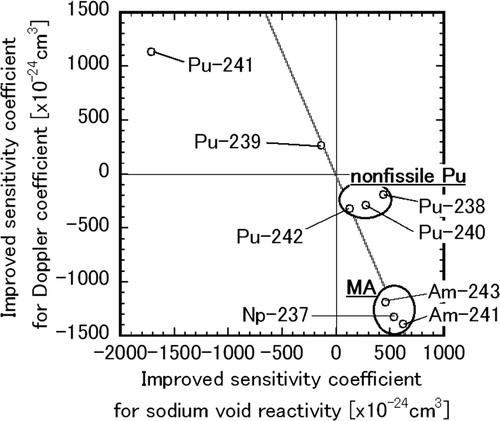
The fuel compositions of the EOEC cores for each typical TRU composition given in are shown in . The EOEC core compositions for the reference and LWR-UOX-3yrs-Pu fuel have relatively higher fractions of fissile Pu and lower fractions of non-fissile Pu and MAs. On the other hand, those for ALWR-UOX-40yrs-TRU and ALWR-MOX-100yrs-TRU have relatively lower fissile Pu fractions and higher non-fissile Pu and MA fractions. The feature seems to be common between fresh fuel and EOEC core fuel. Thus, the TRU compositions are mildly changed by bunrnup in these cores (roughly speaking, the depleted uranium is replaced by the fission products (FPs) in ). This is confirmed from the fact that the burnup coefficient is insusceptible to burnup, as shown in .
From the fuel compositions in and the improved sensitivity coefficients in , it is found that a TRU composition that has a higher fraction of fissile nuclides makes the sodium void reactivity low and the absolute value of the Doppler coefficient and burnup reactivity high. In contrast, a TRU composition that has a lower fraction of fissile nuclides makes the sodium void reactivity high and the absolute value of the Doppler coefficient and burnup reactivity low. This qualitatively explains the relations shown in and .
5. Development of a simplified index for burnup reactivity
In Chapter 3, the correlations between core characteristics that are significant for core design were found, and it was clarified that the burnup reactivity is one of the important parameters for specifying the key TRU compositions that provide the framework for core reactivity control and core safety properties. In this chapter, with the aid of the discussion of the sensitivity analyses in Chapter 4, a simplified index for burnup reactivity that obviously shows the features of the fuel composition is developed for rapid and rational estimation of the core characteristic variations.
From Equations (1) and (4), the burnup reactivity is represented as follows:
In the point-reactor approximation, the space integrations in parentheses in Equation (13) are removed, and Equation (13) becomes
The variation of the burnup reactivity is proportional to the reactivity loss per fission reaction of a fuel at a certain moment. By dividing the fuel composition into the TRU component and U component, as in Equation (8), and extracting the part associated with the variable from Equation (14), we define a new index related to the burnup reactivity, the “simplified burnup reactivity index,” as follows:
Moreover, for convenience, this index is normalized as follows to the value for Pu-239,
We call this index the “normalized simplified burnup reactivity index.” The index
can be written as a function of only the TRU composition
. This index indicates the reactivity loss per fission reaction of a unit of TRU at a certain moment. From the fact shown in the previous chapter that the burnup coefficient is insusceptible to burnup, it seems reasonable to adopt the fresh fuel TRU compositions for
in Equation (18).
In this paragraph, the index is evaluated for various fresh fuel TRU compositions, and the results are compared to the actual burnup reactivity evaluated using core calculations. To evaluate the index
, the normalized differential reactivity worth coefficient
and the normalized microscopic fission cross section
are necessary. The core averaged
and
values are shown in . These parameters were evaluated in the reference core. For the various fresh fuel TRU compositions obtained from the fuel recycling calculation, a good correlation between the index
and burnup reactivity is obtained, as shown in
. It is clarified that the differences in reactivity worth loss per fission reaction for each fresh fuel TRU composition govern the magnitude of the burnup reactivity of the equilibrium core, at least as long as the TRU enrichment is determined according to a rule like the one in the method adopted in this study.
Table 5. Normalized differential reactivity worth coefficients  and normalized microscopic fission reaction cross sections
and normalized microscopic fission reaction cross sections  .
.
Since the index is dependent only on the given fresh fuel TRU composition, its evaluation requires no neutronic or burnup calculations. Through the development of this simplified index, a given TRU composition and the important core characteristics can easily be connected. We can estimate the core characteristic variations due to fuel composition changes without repeating the detailed core calculations by using this index and the core characteristics correlations in and . This is beneficial for the rapid and rational estimation of the effects of fuel composition on the core characteristics when facing a diversity of fuel compositions.
6. Conclusion
In FBR core design for the L–F transition stage, it is necessary to grasp the effect of the fuel composition variation on the core characteristics, because the different fuels fed to FBRs in this stage have a large variety of compositions. In this study, the FBR core characteristics were evaluated for various fuel compositions supposed for the L–F transition stage, and good correlations between the burnup reactivity and safety parameters such as the sodium void reactivity and Doppler coefficient were found, along with their mechanisms. The mechanism behind these correlations was discussed by using sensitivity analysis. It has been clarified that the correlations are a result of the following nuclide-wise trend of their sensitivity coefficients: the fissile nuclides have negative sensitivity coefficients of the sodium void reactivity and have positive sensitivity coefficients of the Doppler coefficient and burnup reactivity, while the non-fissile nuclides (including MAs) have positive sensitivity coefficients of the sodium void reactivity and have negative sensitivity coefficients of the Doppler coefficient and burnup reactivity. This trend was discovered by considering the constraint imposed by the criticality requirement on the fuel composition variation. These correlations made it easy to specify the various properties ranges for core reactivity control and core safety, which are important for core design in determining the core specifications and performance. Furthermore, the sensitivity analysis made clear not only the mechanism behind these correlations, but also the relation between the fuel composition and the core characteristics. This provides very significant information for FBR core design in the L–F transition stage.
Moreover, as an application of the above-mentioned correlations, the normalized simplified burnup reactivity index was developed for rapid and rational estimation of the core characteristic variations due to fuel composition changes. Through the development of this index, the given TRU composition and the important core characteristics were connected. By using this index and the core characteristic correlations, the core characteristic variations for various fuel compositions can be estimated rapidly and rationally without repeating detailed core calculations.
Nomenclature
| R: | = |
core characteristic |
| Ni : | = |
number density of nuclide i |
| Si : | = |
sensitivity coefficient of nuclide i |
|
| = |
sensitivity coefficient of nuclide i for sodium void reactivity |
|
| = |
sensitivity coefficient of nuclide i for Doppler coefficient |
|
| = |
sensitivity coefficient of nuclide i for burnup reactivity |
| β eff : | = |
effective delayed neutron fraction |
| ρ: | = |
reactivity in unperturbed system |
| ρ V : | = |
reactivity in sodium-voided system |
| ρ D : | = |
reactivity in temperature-increased system |
|
| = |
burnup coefficient |
| wi : | = |
reactivity worth coefficient of nuclide i in unperturbed system |
|
| = |
reactivity worth coefficient of nuclide i in sodium-voided system |
|
| = |
reactivity worth coefficient of nuclide i in temperature-increased system |
|
| = |
differential reactivity worth coefficient of nuclide i |
| φ: | = |
total neutron flux |
| Mij : | = |
transmutation matrix in burnup equation |
|
| = |
microscopic fission reaction cross section of nuclide i |
|
| = |
microscopic capture reaction cross section of nuclide i |
|
| = |
microscopic (n, 2n) reaction cross section of nuclide i |
|
| = |
microscopic absorption reaction cross section of nuclide i |
| λ i : | = |
decay constant of nuclide i |
| Δρ V : | = |
sodium void reactivity |
| Δρ D : | = |
Doppler reactivity |
| KD : | = |
Doppler coefficient |
| Δρ BU : | = |
burnup reactivity |
| ρBOC: | = |
reactivity at BOC |
| ρEOC: | = |
reactivity at EOC |
|
| = |
improved sensitivity coefficient of nuclide i considering the criticality requirement |
|
| = |
improved sensitivity coefficient of nuclide i for sodium void reactivity |
|
| = |
improved sensitivity coefficient of nuclide i for Doppler coefficient |
|
| = |
improved sensitivity coefficient of nuclide i for burnup reactivity |
| Ti : | = |
number density of TRU nuclide i |
| Ui : | = |
number density of U nuclide i |
|
| = |
TRU composition of nuclide i (amplitude is normalized to unity) |
|
| = |
U composition of nuclide i (amplitude is normalized to unity) |
| n: | = |
total number density of fuel nuclides |
| e: | = |
TRU enrichment |
|
| = |
differential reactivity worth coefficient of U |
|
| = |
microscopic fission reaction cross section of U |
| B: | = |
simplified burnup reactivity index |
|
| = |
normalized differential reactivity worth coefficient of nuclide i |
|
| = |
normalized microscopic fission cross section of nuclide i |
|
| = |
normalized simplified burnup reactivity index |
Additional information
Notes on contributors
Shuhei Maruyama
†Present address: Japan Atomic Energy Agency, 4-33 Muramatsu, Tokai-mura, Naka-gun, Ibaraki 319-1194, Japan.References
- Maruyama , S. , Kawashima , K. , Ohki , S. , Mizuno , T. and Okubo , T. Study on FBR Core Concepts for the LWR-to-FBR Transition Period . Proc. Global 2009 . September 6–11 .
- Ohki , S. , Ogawa , T. , Kobayashi , N. , Naganuma , M. , Kawashima , K. , Maruyama , S. , Mizuno , T. and Tanaka , T. FBR Core Concepts in the “FaCT” Project in Japan . Proc. Int. Conf. Physics of Reactors (PHYSOR '08) . September 14–19 .
- Niwa , H. , Aoto , K. and Morishita , M. Current Status and Perspective of Advanced Loop Type Fast Reactor in Fast Reactor Cycle Technology Development Project . Proc. Global 2007: Advanced Nuclear Fuel Cycles and Systems . September 9–13 .
- Funasaka , H. and Itoh , M. Perspective and Current Status on Fuel Cycle System of Fast Reactor Cycle Technology Development (FaCT) Project in Japan . Proc. Global 2007: Advanced Nuclear Fuel Cycles and Systems . September 9–13 .
- Ishikawa , M. , Sugino , K. , Sato , W. and Numata , K. 2002 . Development of a unified cross-section set ADJ2000 based on adjustment technique for fast reactor analysis . J. Nucl. Sci. Technol , Supplement 2 : 1073 – 1076 .
- Hazama , T. , Chiba , G. , Numata , K. and Sato , W. 2002 . Development of the Unified Cross-section Set ADJ2000R for Fast Reactor Analysis, JNC TN9400 2002-064 , Japan Nuclear Cycle Development Institute (JNC) . [in Japanese], Ibaraki, Japan
- Niwa , H. 1998 . A comprehensive approach of reactor safety research aiming at elimination of recriticality in CDA for commercialization of LMFBR . Prog Nucl Ener , 32 : 621 – 629 .
Appendix A1. Detailed derivation of the sensitivity coefficients
The sensitivity coefficients of the sodium void reactivity, Doppler coefficient, and burnup reactivity are developed here.
The sodium void reactivity of dollar units Δρ V is represented by using the reactivity of an unperturbed system ρ, that of the sodium-voided system ρ V , and the effective delayed neutron fraction βeff as follows:
The variation of the sodium void reactivity due to a fuel composition change is represented by the following relation:
Here, δNi
is the change in atomic number density for nuclide i. The sensitivity coefficient of the sodium void reactivity is defined as , and the reactivity worth coefficients in the unperturbed system wi
and those in sodium-voided system
are also defined.
In a similar way, the variations of the Doppler coefficient KD
and the Doppler reactivity Δρ
D
are represented by using the sensitivity coefficient of the Doppler coefficient :
When these three kinds of reactivity worth coefficients wi
, , and
can be evaluated by a first-order perturbation calculation, the total differentials in Equations (A4) and (A7) can be replaced with partial differentials. This means that the contributions to variations of the sodium void reactivity and Doppler coefficient are evaluated by treating the direct effect of the atomic number density change only.
In the next paragraphs, the sensitivity coefficient of the burnup reactivity is considered. The burnup reactivity Δρ BU is described as the difference between the reactivities at BOC and EOC:
When the reactivity transition in a cycle is almost linear, the relative variation of the burnup reactivity becomes nearly equal to the relative variation of a time derivative of the reactivity at a certain moment in a cycle; hence,
The time derivative of the reactivity can be generated using the transmutation of the fuel nuclides,
: microscopic fission reaction cross section of nuclide i.
: microscopic capture reaction cross section of nuclide i.
: microscopic (n, 2n) reaction cross section of nuclide i.
: microscopic absorption reaction cross section of nuclide i.
The transmutation chain model that is used to configure the transmutation matrix is presented in , where minor reactions are neglected and the nuclides that have extremely short half-lives are not treated explicitly (for example, Np-239, whose half life is 2.3565 days, is treated as decaying instantaneously to Pu-239). Substituting Equation (A11) into Equation (A10), one obtains
The dependence of transmutation matrix Mij on the total neutron flux φ is neglected. The total neutron flux φ contained in Equation (A12) is influenced by the fuel composition change due to the reactor power normalization. To separate out this dependency, the approximation
The index is referred to as the “differential reactivity worth coefficient.”
The sensitivity coefficients introduced here are then improved by considering a constraint. The variation of a core characteristic integrated over the core region is represented as follows:
The contributions from the nuclides in the blanket fuel and the structural material are negligible when only the core fuel composition is changed. In addition, the contribution from the FP nuclides is also negligible when the cycle length and reactor power are kept constant. Thus, the contribution in Equation (A18) mainly comes from heavy metal (HM) nuclides in core fuels. Dividing the HM component of the nuclide number density Ni (i ∈ HM) into the TRU component Ti (i ∈ TRU) and the U component Ui (i ∈ U), one obtains
where
Here, n is the total number density of fuel nuclides, e is the enrichment of TRU, is the TRU composition of nuclide i, and
is the U composition of nuclide i. Note that n is constant, and, furthermore, when the U composition can be regarded as constant, i.e. when
, Equation (A19) becomes
By taking the sodium void reactivity Δρ V , the Doppler coefficient KD , the burnup reactivity ΔρBU, and the reactivity ρ as the core characteristic R in Equation (A24), we obtain
When the constraint δρ ≈ 0 is imposed, Equation (A28) becomes
By substituting Equation (A29) into Equation (A25), we obtain
In a similar way, for the Doppler coefficient and burnup reactivity we have
These sensitivity coefficients considering the constraint imposed by the criticality requirement in Equations (A31), (A33), and (A35) are called the “improved sensitivity coefficients” of the sodium void reactivity, Doppler coefficient, and burnup reactivity, respectively.
Appendix A2. A Physical interpretation of the sensitivity coefficients
The sensitivity coefficients of the sodium void reactivity, Doppler coefficient, and burnup reactivity are analyzed in detail here.
The sensitivity coefficient of the sodium void reactivity exhibits a large negative value for fissile nuclides (i.e. Pu-239 and Pu-241) and a large positive value for MA nuclides (i.e. Np-237, Am-241, and Am-243). For a typical fissile nuclide, Pu-239, and a typical MA nuclide, Am-241, the energy- and reaction-term-wise sensitivity coefficients are shown in Figures A1 and A2. The meanings of the reaction term abbreviations in the legends in these figures are as follows:
Y term: contribution from neutron yield by fission reaction.
A term: contribution from neutron absorption (fission and capture) reaction.
S term: contribution from neutron scattering.
L term: contribution from neutron leakage.
Figures A1 and A2 show that the absolute values of the sensitivity coefficients are large in the keV to MeV energy region. These have some peaks in places. This comes from the difference between the scattering cross section of sodium in the unperturbed system and that in the sodium-voided system. In the sodium-voided system, since there are fewer neutrons moderated by scattering than in the unperturbed system, the neutron flux and the adjoint neutron flux spectra are shifted to the higher energy direction. In contrast, the neutron flux at sodium resonances becomes higher. The difference between the neutron flux spectra (normalized to unity) in the unperturbed and sodium-voided systems is illustrated in . In fact, the shape of this difference is similar to the shapes of the sensitivity coefficients in Figures A1 and A2. The fission reaction is dominant in the energy region around 103–105 eV for fissile nuclides like Pu-239 (see ). Thus, the neutron production is reduced in this region when sodium is voided in the core, so that the net sensitivity coefficient becomes negative for Pu-239. For Pu-241, these features are essentially similar to those of Pu-239. On the other hand, the capture reaction is dominant in the neutron energy region from 103 to 105 eV for MA nuclides like Am-241 (again see ). The lower the neutron energy is, the larger the capture cross section of Am-241 is in this energy region. Thus, the neutron absorption is also reduced in the energy region around 103–105 eV when sodium is voided in the core, so that the net sensitivity coefficient becomes positive for Am-241. For Np-237 and Am-243, these features are essentially similar to those of Am-241.
Figure A1. Energy- and reaction-term-wise sensitivity coefficients of sodium void reactivity for Pu-239.

Figure A2. Energy- and reaction-term-wise sensitivity coefficients of sodium void reactivity for Am-241.
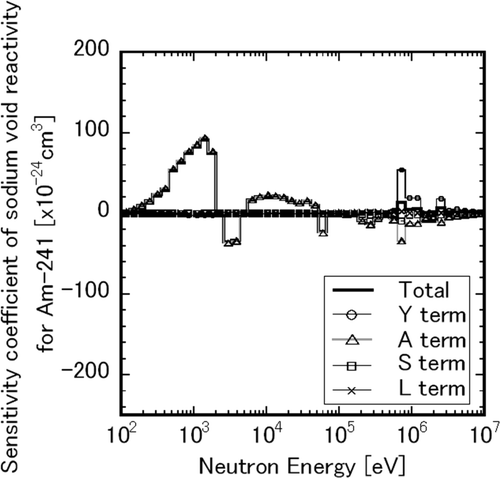
The sensitivity coefficient of the Doppler coefficient has a positive value for U-238 and negative values for the other nuclides. The energy- and reaction-term-wise sensitivity coefficients of U-238, Pu-239, and Am-241 are shown in Figures A5–A7, respectively. Uranium-238 has a positive sensitivity coefficient in the keV energy region, as shown in . This is caused by the increment of the resonance absorption reaction resulting from the addition of U-238. For Pu-239, the Y-term in the energy region over 1 keV provides a large negative contribution to the sensitivity coefficient (see ). For Am-241, both the A-term in the keV region and the Y-term in the MeV region result in its negative sensitivity coefficient (see ). The mechanism behind these contributions is the decrease of the neutron flux and adjoint neutron flux spectra in the keV region and the relative increase in the MeV region caused by an increment of the resonance absorption reaction of U-238 in the temperature-increased system. The difference between the neutron flux spectra (normalized to unity) of the unperturbed and temperature-increased systems is presented in . Thus, for fissile nuclides like Pu-239, which are dominated by the fission reaction, especially in the region over 1 keV, the increment of neutron production results in a negative sensitivity coefficient. In contrast, for non-fissile nuclides like Am-241, which are dominated by the capture reaction in the keV region and by the fission reaction in the MeV region, the decrement of the neutron absorption in the keV region and the increment of the neutron production in the MeV region result in negative sensitivity coefficients.
Figure A5. Energy- and reaction-term-wise sensitivity coefficients of Doppler coefficient for U-238.
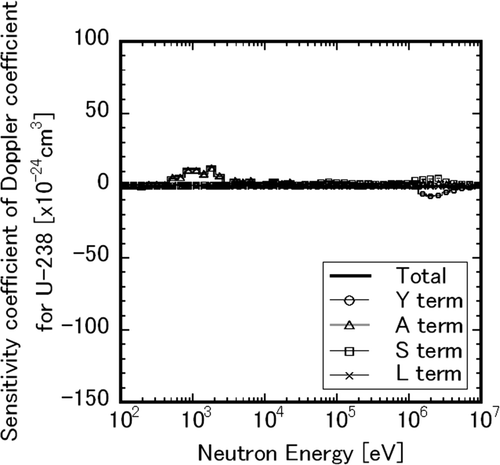
Figure A6. Energy- and reaction-term-wise sensitivity coefficients of Doppler coefficient for Pu-239.
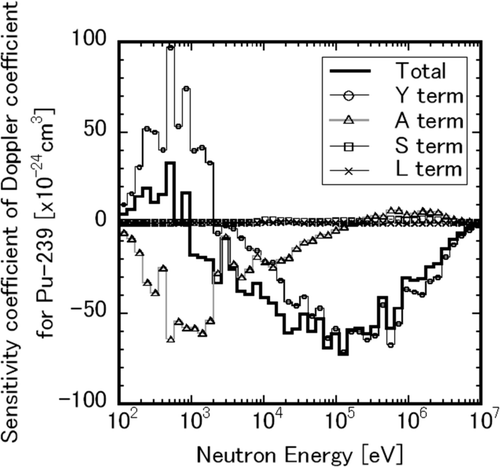
Figure A7. Energy- and reaction-term-wise sensitivity coefficients of Doppler coefficient for Am-241.

Figure A8. Difference between neutron flux spectra for temperature-increased system and unperturbed system.
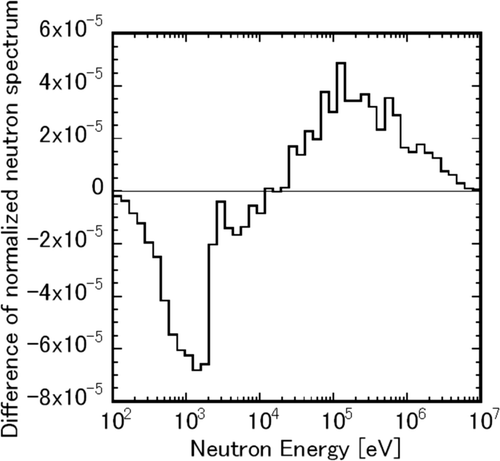
The sensitivity coefficient of the burnup reactivity tends to be positive for fissile nuclides like Pu-239 and Pu-241 and to be negative for non-fissile nuclides, especially MA nuclides like Np-237, Am-241, and Am-243. Since fissile nuclides have larger positive reactivity worth coefficients, the reactivity loss due to the absorption reaction during burnup becomes quite large. On the other hand, since non-fissile nuclides usually have smaller positive or negative reactivity worth coefficients, and they transform to nuclides that have larger positive reactivity worth coefficients, i.e. fissile nuclides, which causes the reactivity loss due to burnup to become smaller.
